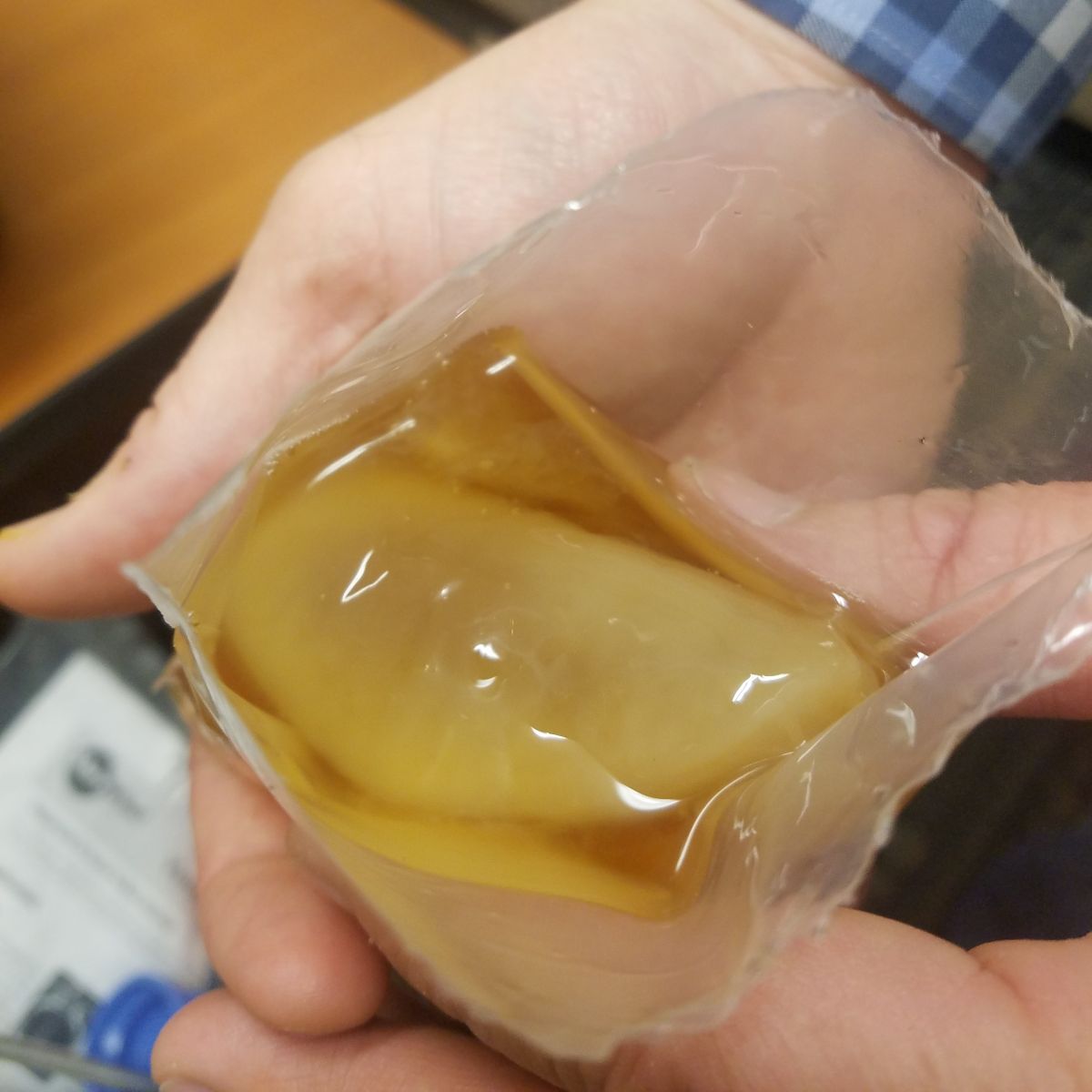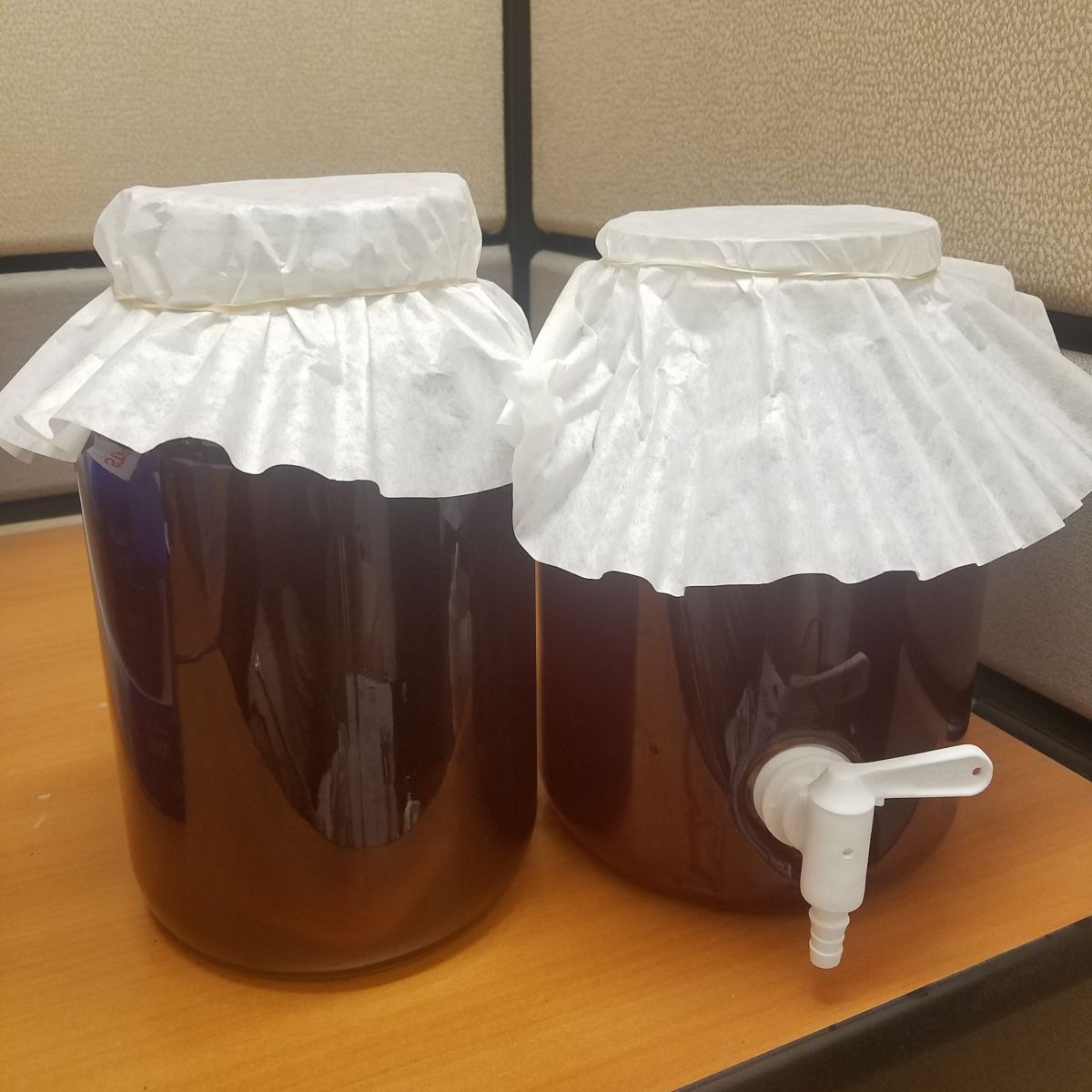-
Kombucha is a fermented beverage made with tea, sugar, and water.
-
A SCOBY is a culture of yeast and bacteria which feeds on the sugar and nutrients of the tea. You can buy a SCOBY from us or grow you own.
-
The type of tea you use is important. Black tea is the most common, but white and green teas can also be used. Any tea flavored with essential oils, like chai and Earl Grey must be avoided.
-
There are two methods for brewing kombucha: batch brewing and continuous brewing.
-
Equipment needed is minimal: a source for boiling water, a pot for brewing tea, and a fermentation-safe jar.
-
Need a Kombucha recipe? Click here to view ours!
-
Once your kombucha is done fermenting, you can customize it with fruits or other flavorings.
What is Kombucha?
Kombucha starts with a mixture of brewed tea and sugar, which is fermented by a culture of yeast and bacteria. The result is a beverage that boasts a balanced blend of acidity and sweetness, with the sharpness of vinegar. For comparison, the pH of plain white distilled vinegar is often right around 2.4, while finished kombucha typically tests at 2.5 - 3.5 pH. The acidity of this beverage can be quite intense for a first time drinker, which is why it is usually enjoyed in small portions, and said to be an acquired taste. Commercial kombucha is usually always sold carbonated, which helps to transform the fermented tea into a fizzy and effervescent beverage that is refreshing and enjoyable to drink.
In this article, we’ll go over how to obtain the crucial culture needed for fermentation (a SCOBY), as well as look at the different methods of brewing, and the equipment needed. Then we’ll go over a beginner's brewing recipe, look at the different types of tea that can be used, and discuss when to add optional flavorings to improve your kombucha. Finally, I’ll recap what I learned from my first brew day, and what I’m eager to try next.
What is a SCOBY?
The key ingredients of kombucha are water, tea, sugar, and a SCOBY, which is a
Symbiotic
Culture
Of
Bacteria and
Yeast. There are a few ways to obtain a SCOBY, one of which is by
purchasing it, or by getting one from a friend. As you continue to brew kombucha with your SCOBY, it eventually grows new layers, which must be removed in order to allow oxygen to normally pass through. If you know anyone that brews kombucha regularly, they’re likely to have a piece of their SCOBY that they’d be willing to give you.
Grow Your Own SCOBY!
The third way to obtain a SCOBY is to grow your own at home, which is easier than it sounds. By purchasing a bottle of unflavored kombucha that is raw and unfiltered, there will be enough culture left behind in the bottle to kick off fermentation in your homemade batch. The commercial bottle of kombucha should be left out the night before brewing, which will encourage the culture to flocculate, indicating it’s ready for use. The batch of kombucha will leave behind a baby SCOBY on the surface, which will increase in size and thickness over time. While the SCOBY feeds off of sugar, it also relies on nutrients provided by the tea. The type of tea used in kombucha is as important as any decision you make while brewing.
Types of Tea
The type of tea used in your kombucha will have an effect on the flavor of your final product. Additionally, the tea plays a crucial role in fermentation, providing nutrients for the SCOBY to feed on. Most commonly, you’ll see recipes that feature a combination of green and black tea for flavor and nutrients. You can use green tea, white tea, or black tea, or a combination of two or three of these depending on the flavor that you desire. It is important to try to obtain the highest quality tea possible, and in this case, organic tea is almost a necessity.
There are some teas that should be avoided, however, as their ingredients can harm the SCOBY. Any tea that is flavored with essential oils, such as chai or Earl Grey, should be avoided due to the adverse effects that they may have on the culture. Additionally, herbal blends or those that are flavored and infused with oils and flavors should also be avoided for the same reason.
Types of Brewing Methods
There are two different types of brewing methods for making kombucha at home: batch brewing and continuous brewing. Both of these methods are simple, and can be utilized by beginners, and the main distinction is whether or not you expect to be making kombucha regularly.
It doesn't take much special equipment to utilize either method. You'll need a way to heat water, a large enough kettle or pot where you can brew your tea, and a jar for fermentation. In continuous brewing, it’s best to use a jar that is ported and has a spigot at the bottom for ease of transferring. You'll then need to have the jar covered during fermentation, and we don't recommend using cheesecloth for this, because fruit flys can penetrate this.
Batch brewing might be best for the first time brewer, as it’s ideal for anyone looking to brew the occasional batch. In this method, you’re brewing with a ratio that is roughly a 9 to 1 solution -- that is, 9 parts of sugar and tea to 1 part starter. You’ll start by putting your sweet tea, SCOBY, and a small amount of starter liquid (typically from a previous batch of kombucha or from a commercial bottle), into a jar, and cover it with a cloth secured with rubber bands to ferment at room temperature for roughly 7 days, or until it tastes to your liking. The finished kombucha is then transferred from the jar and off of the SCOBY, and into bottles for carbonating, if desired. Once done, you then have to figure out how to store and preserve your SCOBY until the next time you brew. This is why the alternative method, the continuous method, is ideal for preserving your SCOBY, and making kombucha regularly.
Continuous brewing has many benefits, including that it saves time and money. This method encourages you to leave behind roughly 25% of your fermented tea after each brew, preserving your SCOBY, and allowing you to refill and begin brewing when you’re ready atop this starter liquid. This distinction means that there will be a ratio that is roughly a 3 to 1 solution of sugar and tea to starter liquid, and because of this stronger solution, it should finish fermenting in only a day or two, which is much faster compared to the 7 days the batch method requires.
Kombucha Ingredients and Recipe
One of the joys of making kombucha is how it encourages experimentation and creativity. That being said, you need a recipe to start with, and we’ve got a great recipe for brewing your first batch, and growing your own SCOBY:
-
16 bags of black tea steeped in 5 cups of filtered water
-
1 cup of white cane sugar
-
2 cups of starter liquid from raw unflavored kombucha
To begin, steep your tea for 4 minutes in 5 cups of water heated to 180 degrees fahrenheit. After 4 minutes, remove your tea bags, and add in your sugar, and mix until dissolved. In order to cool down and dilute this mixture, pour in roughly 9 cups of cold water. Once it is below 80 degrees fahrenheit, transfer to your fermenting vessel, and add in 2 cups of raw unflavored kombucha. Cover the opening of your vessel with a coffee filter, and/or towel or t-shirt to encourage oxygen exchange. Store your vessel at room temperature out of direct sunlight, and monitor the growth and development of your SCOBY. After 7 to 10 days, use a straw to taste your kombucha. When finished, there will be a pronounced balance of acidity and sweetness.
Flavoring Your Kombucha
The time to add flavorings to your kombucha is after it’s completed fermentation. Flavorings like fruit will not only aid in enhancing the overall flavor of your beverage, but, when blended at the time of bottling, will encourage secondary fermentation for carbonation. It’s always best to use the highest quality fruit you can find, with organic being ideal when possible. Fruits like berries, grapes, apples, and mangos can be juiced or pureed, and strained if desired, before adding to taste directly to the bottles before sealing and allowing to carbonate at room temperature. Other flavoring options include fresh or dried herbs, which you can steep with the kombucha for a couple of days in a secondary vessel before bottling. You can even add hops in secondary, making dry-hopped kombucha in the same way you would with home brewed beer.
What I Learned on Brew Day
The main takeaway from my first brew day is that brewing kombucha is incredibly easy to do; if you can brew tea, then you can brew kombucha! What’s most exciting about brewing kombucha is how little time it takes on “brew day,” and how quickly fermentation completes.
I brewed two batches: one utilizing the batch method where I grew my own SCOBY, and one utilizing the continuous method using a
purchased SCOBY. For the batch method, I poured a bottle of unfiltered kombucha that I bought from the store into the fermenter, and after about 8 days of fermentation, a small culture began to form at the top of the jar. Both produced great results and had slight diffrences in aroma and flavor.
The base kombucha is so easy to customize that I can’t wait to brew more. Brewing with only black tea this first time makes me eager to try incorporating green and white teas, as I prefer drinking these on their own, and I want to see the effect it has on the fermented product. With so many options for flavoring, I know that I’ll be continuing to experiment to find the perfect balance.
The batch method is certainly easy to do once as a weekend project with a group of friends like I did, but if you’re planning on brewing regularly, the continuous method is perfect. It’ll reduce contact time with the SCOBY and thus reduce some of the contamination risk, while also increasing the strength of the final product, and speed up the fermentation process.


